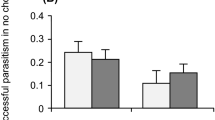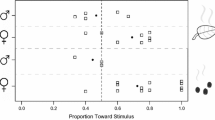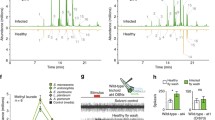Abstract
Chemical information mediates species interactions in a wide range of organisms. Yet, the effect of chemical information on population dynamics is rarely addressed. We designed a spatio-temporal parasitoid—host model to investigate the population dynamics when both the insect host and the parasitic wasp that attacks it can respond to chemical information. The host species, Drosophila melanogaster, uses food odors and aggregation pheromone to find a suitable resource for reproduction. The larval parasitoid, Leptopilina heterotoma, uses these same odors to find its hosts. We show that when parasitoids can respond to food odors, this negatively affects fruit fly population growth. However, extra parasitoid responsiveness to aggregation pheromone does not affect fruit fly population growth. Our results indicate that the use of the aggregation pheromone by D. melanogaster does not lead to an increased risk of parasitism. Moreover, the use of aggregation pheromone by the host enhances its population growth and enables it to persist at higher parasitoid densities.




Similar content being viewed by others
References
Allee WC (1931) Animal aggregations, a study in general sociology. University of Chicago Press, Chicago
Allemand R, Fleury F, Lemaître C, Boulétreau M (1999) Population dynamics and competitive interactions in two species of Leptopilina (Hymenoptera : Figitidae) which parasitize Drosophila in the Rhone valley (S-E France). Ann Soc Entomol Fr 35:97–103
Allen JC, Brewster CC, Slone DH (2001) Spatially explicit ecological models: a spatial convolution approach. Chaos Solitons Fractals 12:333–347
Ashburner M, Golic KG, Hawley RS (2005) Drosophila: a laboratory handbook. (2nd ed). Cold Spring Harbor Laboratory Press, pp. 162–164
Bartelt RJ, Schaner AM, Jackson LL (1985) Cis-vaccenyl acetate as an aggregation pheromone in Drosophila melanogaster. J Chem Ecol 11:747–1756
Bell WJ, Cardé RT (1984) Chemical ecology of insects. Chapman & Hall, London New York
Berec L, Boukal DS, Berec M (2001) Linking the Allee effect, sexual reproduction, and temperature-dependent sex determination via spatial dynamics. Am Nat 157:217–230
Boulétreau-Merle J, Fouillet P, Varaldi J (2003) Divergent strategies in low temperature environments for the sibling species Drosophila melanogaster and D. simulans: overwintering in extension border areas of France and comparison with African populations. Evol Ecol 17:523–548
Brewster CC, Allen JC (1997) Spatiotemporal model for studying insect dynamics in large-scale cropping systems. Environ Entomol 26:473–482
Bruinsma M, Dicke M (2008) Herbivore-induced indirect defence: from induction mechanisms to community ecology. In: Schaller A (ed) Induced plant resistance to herbivory. Springer, Berlin, pp 31–60
Bukovinszky T, Gols R, Hemerik L, Van Lenteren JC, Vet LEM (2007) Time allocation of a parasitoid foraging in heterogeneous vegetation: implications for host-parasitoid interactions. J Anim Ecol 76:845–853
Cardé RT, Miller J (2004) Advances in insect chemical ecology. Cambridge University Press, Cambridge
Charnov EL (1976) Optimal foraging: the marginal value theorem. Theor Popul Biol 9:129–136
De Boer JG, Dicke M (2004) Experience with methyl salicylate affects behavioural responses of a predatory mite to blends of herbivore-induced plant volatiles. Entomol Exp Appl 110:181–189
de Gee M, Lof ME, Hemerik L (2008) The effect of chemical information on the spatial distribution of fruit flies: II parameterization, calibration and sensitivity. Bull Math Biol 70:1850–1868
de Moraes CM, Lewis WJ, Paré PW, Alborn HT, Tumlinson JH (1998) Herbivore-infested plants selectively attract parasitoids. Nature 393:570–573
Dicke M, Baldwin IT (2010) The evolutionary context for herbivore-induced plant volatiles: beyond the ‘cry for help’. TIPS 15:167–175
Dicke M, Grostal P (2001) Chemical detection of natural enemies by arthropods: an ecological perspective. Annu Rev Ecol Syst 32:1–23
Dicke M, Sabelis MW (1988) Infochemical terminology: based on cost-benefit analysis rather than origin of compounds? Funct Ecol 2:31–139
Dicke M, Takken W (eds) (2006) Chemical ecology: from gene to ecosystem. Springer, Dordrecht
Dicke M, Van Lenteren JC, Boskamp GJF, Van Voorst R (1985) Intensification and prolongation of host searching in Leptopilina heterotoma (Thomson) (Hymenoptera: Eucoilidae) through a kairomone produced by Drosophila melanogaster. J Chem Ecol 11:125–136
Dicke M, Vet LEM, Wiskerke JSC, Stapel O (1994) Parasitoid of Drosophila larvae solves foraging problem through infochemical detour: conditions affecting employment of this strategy. Nor J Agric Sci 16:227–232
Etienne RS, Wertheim B, Hemerik L, Schneider P, Powell JA (2002) The interaction between dispersal, the Allee effect and scramble competition affects population dynamics. Ecol Model 148:153–168
Fatouros NE, Huigens ME, Van Loon JJA, Dicke M, Hilker M (2005) Butterfly anti-aphrodisiac lures parasitic wasps. Nature 433:704
Fatouros NE, Dicke M, Mumm R, Meiners T, Hilker M (2008) Foraging behavior of egg parasitoids exploiting chemical information. Behav Ecol 19:677–689
Fleury F, Ris N, Allemand R, Fouillet P, Carton Y, Boulétreau M (2004) Ecological and genetic interactions in Drosophila-parasitoids communities: a case study with D. melanogaster, D. simulans and their common Leptopilina parasitoids in south-eastern France. Genetica 120:181–194
Fraker ME (2008) The dynamics of predation risk assessment: responses of anuran larvae to chemical cues of predators. J Anim Ecol 77:638–645
Godfray HCJ (1994) Parasitoids: behavioral and evolutionary ecology. Princeton University Press, Princeton
Haccou P, De Vlas SJ, Van Alphen JJM, Visser ME (1991) Information processing by foragers: effects of intra-patch experience on the leaving tendency of Leptopilina heterotoma. J Anim Ecol 60:93–106
Hamilton WD (1971) Geometry for the selfish herd. J Theor Biol 31:295–311
Hassell MP (2000) The spatial and temporal dynamics of host—parasitoid interactions. Oxford University Press, Oxford
Hedlund K, Vet LEM, Dicke M (1996) Generalist and specialist parasitoid strategies of using odours of adult drosophilid flies when searching for larval hosts. Oikos 77:390–398
Hirzel AH, Nisbet RM, Murdoch WW (2007) Host-parasitoid spatial dynamics in heterogeneous landscapes. Oikos 116:2082–2096
Hoffmeister TS, Rohlfs M (2001) Aggregative egg distributions may promote species co-existence—but why do they exist? Evol Ecol Res 3:37–50
Holling CS (1959) The components of predation as revealed by a study of small mammal predation of the European pine sawfly. Can Entomol 91:293–320
Ives AR (1992) Continuous-time models of host-parasitoid interactions. Am Nat 140:1–29
Janssen A, Driessen G, de Haan M, Roodbol N (1988) The impact of parasitoids on natural populations of temperate woodland Drosophila. Neth J Zool 38:61–73
Kats LB, Dill LM (1998) The scent of death: chemosensory assessment of predation risk by prey animals. Ecoscience 5:261–394
Lof ME, Etienne RS, Powell J, De Gee M, Hemerik L (2008) The effect of chemical information on the spatial distribution of fruit flies: I model results. Bull Math Biol 70:1827–1849
Lof ME, De Gee M, Hemerik L (2009) Odor-mediated aggregation enhances the colonization ability of Drosophila melanogaster. J Theor Biol 258:363–370
Monod J (1949) The growth of bacterial cultures. Annu Rev Microbiol 3:371–394
Morais PB, Martins MB, Klaczko LB, Mendonça-Hagler LC, Hagler AN (1995) Yeast succession in the Amazon fruit Parahancornia amapa as resource partitioning among Drosophila spp. Appl Environ Microbiol 61:4251–4257
Neubert MG, Kot M, Lewis MA (1995) Dispersal and pattern formation in a discrete-time predator–prey model. Theor Popul Biol 48:7–43
Nguyen-Huu T, Let C, Poggiale JC, Auger P (2006) Effect of movement frequency on global host—parasitoid spatial dynamics with unstable local dynamics. Ecol Model 197:290–295
Ostränd F, Anderbrant O (2003) From where are insects recruited? A new model to interpret catches of attractive traps. Agric For Entomol 5:163–171
Parrish JK, Edelstein-Keshet L (1999) Complexity, pattern, and evolutionary trade-offs in animal aggregation. Science 284:99–101
Pearce IG, Chaplain MAJ, Schofield PG, Anderson ARA, Hubbard SF (2006) Modelling the spatio-temporal dynamics of multi-species host-parasitoid interactions: heterogeneous patterns and ecological implications. J Theor Biol 241:876–886
Pearce IG, Chaplain MAJ, Schofield PG, Anderson ARA, Hubbard SF (2007) Chemotaxis-induced spatio-temporal heterogeneity in multi-species host-parasitoid systems. J Math Biol 55:365–388
Powell JA, McMillen T, White P (1998) Connecting a chemotactic model for mass attack to a rapid integro-difference emulation strategy. SIAM J Appl Math 59:547–572
Puente M, Magori K, Kennedy GG, Gould F (2008) Impact of herbivore-induced plant volatiles on parasitoid foraging success: a spatial simulation of the Cotesia rubecula, Pierus rapae, and Brassica oleracea system. J Chem Ecol 34:959–970
Raffa KF, Hobson KR, Lafontaine S, Aukema BH (2007) Can chemical communication be cryptic? Adaptations by herbivores to natural enemies exploiting prey semiochemistry. Oecologia 153:1009–1019
Rohlfs M (2006) Genetic variation and the role of insect life history traits in the ability of Drosophila larvae to develop in the presence of a competing filamentous fungus. Evol Ecol 20:271–289
Rohlfs M, Hoffmeister TS (2003) An evolutionary explanation of the aggregation model of species coexistence. Proc R Soc Lond B 270(suppl 1):S33–S35
Rohlfs M, Obmann B, Petersen R (2005) Competition with filamentous fungi and its implication for a gregarious lifestyle in insects living on ephemeral resources. Ecol Entomol 30:556–563
Schofield PG, Chaplain MAJ, Hubbard SF (2002) Mathematical modelling of host-parasitoid systems: effects of chemically mediated parasitoid foraging strategies on within- and between-generation spatio-temporal dynamics. J Theor Biol 214:31–47
Schofield PG, Chaplain MAJ, Hubbard SF (2005) Dynamic heterogeneous spatio-temporal pattern formation in host-parasitoid systems with synchronized generations. J Math Biol 50:559–583
Shiojiri K, Takabayashi J, Yano S, Takafuji A (2001) Infochemical mediated tritrophic interaction webs on cabbage plants. Popul Ecol 43:23–29
Stamps JA, Yang LH, Morales VM, Boundy-Mills KL (2012) Drosophila regulate yeast density and increase yeast community similarity in a natural substrate. PLoS One 7:e42238
Tentelier C, Fauvergue X (2007) Herbivore-induced plant volatiles as cues for habitat assessment by a foraging parasitoid. J Anim Ecol 76:1–8
Tilman D, Kareiva P (eds) (1997) Spatial ecology: the role of space in population dynamics and interspecific interactions. Princeton University Press, Princeton
Turchin P (1998) Quantitative analysis of movement: measuring and modeling population redistribution in animals and plants. Sinauer Associates Inc., Sunderland
Turlings TCJ, Loughrin JH, McCall PJ, Rose USR, Lewis WJ, Tumlinson JH (1995) How caterpillar-damaged plants protect themselves by attracting parasitic wasps. Proc Natl Acad Sci U S A 92:4169–4174
Van LENTEREN JC, Bakker K (1978) Behavioural aspects of the functional responses of a parasitoid (Pseudeucoila bochei Weld) to its host (Drosophila melanogaster). Neth J Zool 28:213–233
Vet LEM (1999) From chemical to population ecology: infochemical use in an evolutionary context. J Chem Ecol 25:31–49
Vet LEM, Dicke M (1992) Ecology of infochemical use by natural enemies in a tritrophic context. Ann Rev Entomol 37:141–172
Wajnberg E, Bernstein E, Van Alphen JJM (eds) (2008) Behavioral ecology of insect parasitoids: from theoretical approaches to field applications. Blackwell Publishing Ltd, Oxford
Wajnberg E, Coquillard P, Vet LEM, Hoffmeister T (2012) Optimal resource allocation to survival and reproduction in parasitic wasps foraging in fragmented habitats. PLoS One 7:e38227
Wall C, Perry JN (1987) Range of action of moth sex-attractant sources. Entomol Exp Appl 44:5–14
Wertheim B (2001) Individual risk of parasitism in host aggregations: a behaviour-based model on functional and numerical responses. Ecology of Drosophila aggregation pheromone: a multitrophic approach. pp. 111–138. PhD Thesis, Wageningen University, Wageningen, The Netherlands
Wertheim B, Marchais J, Vet LEM, Dicke M (2002) Allee effect in larval resource exploitation in Drosophila: an interaction among density of adults, larvae, and micro-organisms. Ecol Entomol 27:608–617
Wertheim B, Vet LEM, Dicke M (2003) Increased risk of parasitism as ecological costs of using aggregation pheromones: laboratory and field study of Drosophila - Leptopilina interaction. Oikos 100:269–282
Wertheim B, Van Baalen E-J, Dicke M, Vet LEM (2005) Pheromone-mediated aggregation in nonsocial arthropods: An evolutionary ecological perspective. Ann Rev Entomol 50:321–346
Wertheim B, Allemand R, Vet LEM, Dicke M (2006) Effects of aggregation pheromone on individual behaviour and food web interactions: a field study on Drosophila. Ecol Entomol 31:216–226
Wiskerke JSC, Dicke M, Vet LEM (1993) Larval parasitoid uses aggregation pheromone of adult hosts in foraging behaviour: a solution to the reliability-detectability problem. Oecologia 93:145–148
Wyatt TD (2004) Breaking the code: illicit signallers and receivers of semiochemical signals. In: Pheromones and animal behaviour: communication by smell and taste. Cambridge University Press, Cambridge, pp 229–250
Author information
Authors and Affiliations
Corresponding author
Electronic Supplementary Material
Below is the link to the electronic supplementary material.
Supplementary Material S1
(DOCX 91.8 kb)
Supplementary Material S2
(DOCX 43 kb)
Fig. S3
In all eight figures the x-axis shows the log (base 10) of the total number of fruit fly larvae present in the orchard. The top line of figures represents the fate of the larvae population for the fixed number of parasitoids and the bottom line of figures the same for the fixed fraction of parasitoids. The (a) + (e) figures show percentage mortality due to the Allee effect, the (b) + (f) figures percentage mortality due to competition, the (c) + (g) figures percentage parasitism and the (d) + (h) figures the percentage survival. (PDF 89 kb)
Table S4
(DOCX 18 kb)
Table S5
(DOCX 32 kb)
Rights and permissions
About this article
Cite this article
Lof, M.E., De Gee, M., Dicke, M. et al. Exploitation of Chemical Signaling by Parasitoids: Impact on Host Population Dynamics. J Chem Ecol 39, 752–763 (2013). https://doi.org/10.1007/s10886-013-0298-8
Received:
Revised:
Accepted:
Published:
Issue Date:
DOI: https://doi.org/10.1007/s10886-013-0298-8




